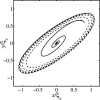Coevolutionary arms races between bacteria and bacteriophage
- PMID: 15976021
- PMCID: PMC1172273
- DOI: 10.1073/pnas.0504062102
Coevolutionary arms races between bacteria and bacteriophage
Abstract
We propose a computational and theoretical framework for analyzing rapid coevolutionary dynamics of bacteriophage and bacteria in their ecological context. Bacteriophage enter host cells via membrane-bound surface receptors often responsible for nutrient uptake. As such, a selective pressure will exist for the bacteria to modify its receptor configuration and, in turn, for the phage to modify its tail fiber. A mathematical model of these trait adaptations is developed by using the framework of adaptive dynamics. Host strains differ in their efficiency of resource uptake and resistance to phage, whereas phage strains differ in their host preference for adsorption. We solve the evolutionary ecology model and find the conditions for coevolutionary branching and relevant dimensionless parameters leading to distinct quasispecies. We confirm these calculations using stochastic Monte Carlo simulations of populations evolving in a chemostat with fixed washout rate and inflow resource density. We find that multiple quasispecies of bacteria and phage can coexist in a homogeneous medium with a single resource. When diversification occurs, quasispecies of phage adsorb effectively to only a limited subset of the total number of quasispecies of bacteria, i.e., functional differences between quasispecies arise endogenously within the evolutionary ecology framework. Finally, we discuss means to relate predictions of this model to experimental studies in the chemostat, using the model organisms Escherichia coli and the virulent strain of lambda phage.
Figures




References
-
- Hutchinson, G. E. (1961) Am. Nat. 95, 137-145.
-
- Armstrong, R. A. & McGehee, R. (1980) Am. Nat. 115, 151-170.
-
- Gause, G. F. (1934) The Struggle for Existence (Williams and Wilkins, Baltimore). - PubMed
-
- Hutchinson, G. E. (1959) Am. Nat. 93, 254-259.
Publication types
MeSH terms
LinkOut - more resources
Full Text Sources
Research Materials

